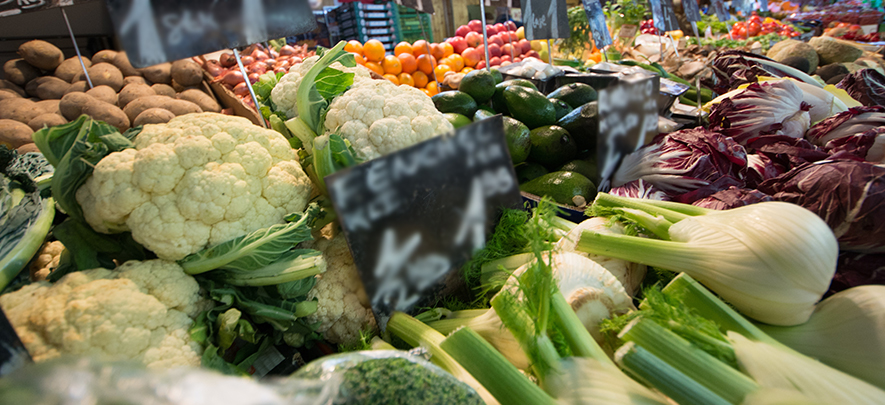Solving India’s food wastage issue with IoT

Digital & Technology
358 week ago — 9 min read
Summary: India, despite its vast population, produces enough food to feed all its citizens. Yet, food wastage is endemic and severely inhibits the ability of the market and the government to create solutions to solve for shortages. Today, technology, specifically the Internet of Things, promises a change in how produce is transferred from the farms to plate by managing efficiency in all the machines used in the process. It is estimated that loss of food worth over INR 90,000 crore can be prevented. Read more to understand how food wastage can become a thing of the past in India.
An estimated 5 to 16% of the 400 million metric tonnes of perishables India produces every year is wasted even before it reaches the end consumer. The wastage, estimated to cost a whopping INR 92,651 crore annually, can be prevented using smart IoT-based solutions that can not just monitor produce during storage, transportation and eventual sale, but also provide valuable data on performance of critical equipment that are part of the supply chain, benefitting every participant in the value chain.
It is an unconscionable irony that in a country which ranks 114 out of 132 on a list of nations with most malnourished children under the age of 5, more than 12% of all food produced (in value terms) is wasted. India’s agricultural industry churns out $114 billion-worth of food every year of which $14 billion is wasted even before it reaches the end consumer. The reasons for such colossal wastage are many: from inadequate farmer training to improper handling and storage to a lack of sufficient cold chain network to refrigeration issues at the retail level.
Not surprisingly, then, the government of India has made prevention of food wastage a top policy goal. An important part of this strategy would be investment in new infrastructure facilities: like food processing units, cold chains, and refrigerated trucks. An Assocham-Grant Thornton study estimates that India has the potential to attract $33 billion in investment by 2024. Given that India is the second largest producer of food after China but less than 10% of its perishables get processed (compared to 80% in the US and 30% even in Thailand), the scope for investment is indeed enormous.
Even as we await the crucial investment in food infrastructure, there is much scope for reducing wastage and improving efficiency in the existing value chain by deploying relatively low-cost, but state-of-the-art technology using the Internet of Things (IoT). Before we look at how IoT can revolutionise the food industry, let’s take a quick look at what IoT is.
Kevin Ashton, a British technologist, is often credited with coining the term the “Internet of Things”. Ashton says he first used the term in a presentation made to the executives of P&G with regard to the use of radio frequency identification (RFID) tags in supply chain management. Shorn of jargon, the IoT is nothing but connecting devices (or things) wirelessly over the internet to collect and exchange data among themselves with the idea of better managing either the device itself or the environment in which it is placed. The IoT accomplishes this by using sensors (which collect data), a gateway to aggregate and pre-process data, a cloud platform that stores and analyses data, and an application that offers an interface to designated end users.
Now, let’s look at how an IoT-based solution can help prevent wastage and improve efficiency in the food industry. To begin with, let’s take the last mile first: the retail stores. In most modern retail chains, refrigerated foods (like meat, milk and processed milk products, and frozen or fresh vegetables) comprise a large part of their revenue. For some high-end stores, the figure can be as high as 40%. The authors’ conversations with some retailers suggest that there are usually 3 minor refrigeration-related issues and one major fault every month, resulting in 25% wastage of perishable food. Additionally, improper closing of refrigerator door can not only result in sub-optimal temperature, but also a higher energy bill. As one can imagine, energy-intensive refrigeration is a large part of a store’s operating expenses (See Key Drivers of Refrigeration Monitoring).
In such a situation, what kind of an IoT solution would the retail chain need to a) monitor all its refrigerated items and refrigerator door opening and closing, b) get alerted in case of temperature rising above permissible levels or refrigeration failure, and c) a redressal system, involving store personnel, the OEM (refrigerator manufacturer) and the maintenance agency? The IoT solution would need to bring together sensors, a communications gateway, a cloud platform, and a device-agnostic dashboard (See IoT-based Refrigeration Monitoring Architecture). The sensor, embedded inside the refrigerator, will collect real-time data on the refrigerator temperature. It will transmit the data wirelessly over the internet at required intervals to a cloud-based platform, where the data will be stored and analysed. The customer—that is, the retail chain—will get visibility into all its refrigerators, no matter which part of the country they are in, on a simple dashboard be it on a desktop, laptop or any mobile device. A refrigerator decides to conk off after the store has shut for the day? No problem. The store manager (and the manager’s boss and others as decided in the escalation matrix) will get an immediate notification/call. Pending repairs, the store manager can simply return to the store and move the perishable contents of the broken refrigerator to another functioning refrigerator. A simple solution, but one that has prevented wastage worth a few tens of thousands of rupees.
Now, let’s start going upstream in the value chain. A refrigerated truck must bring perishable goods to the retailer’s store. But the retailer has no way of knowing if the products were transported at the recommended temperature throughout the journey. This can be crucial in the case of highly temperature-sensitive products like meat, fishery and milk. Unless refrigerated properly, these products can quickly spoil due to bacterial growth. Some fruits and vegetables, on the other hand, suffer from “chilling injury” when they are exposed to too low temperatures.
The only way to ascertain that the goods in the reefer truck were transported at recommended temperatures is by placing a sensor inside the truck. Using wireless communication, the data can be monitored real time. The data so generated can also be used for any regulatory audit requirement. Even something as mundane as unauthorised opening of the truck container in transit can be detected using sensors.
Going a step further up, IoT-based solutions can be deployed in cold chains to monitor temperature, humidity levels, and even product safety and integrity. India currently has a cold chain capacity of about 32 million tonnes, of which nearly three-fourths is used by just one product: potatos (Interestingly enough, potato’s contribution to revenue is just 20 per cent, despite its disproportionate share of cold storage capacity.) Given the current capacity, only 11% of the food produced can be stored in cold chains. Therefore, the need to ‘sweat’ these scarce assets is tremendous and that’s precisely what IoT-based solutions can help do.
Of course, foods is just one industry that can be revolutionised by the IoT. The entire transport and logistics industry (including urban transport, commercial shipping, warehousing etc), smart cities, healthcare, pharmaceuticals, entertainment, and manufacturing industries are among the industries that can benefit from IoT solutions. The challenges for users (companies and consumers) and technology providers centre around industry standards, security, and connectivity (to handle a rising tsunami of data). None of these is a challenge that the technology industry has not faced before. Therefore, there is no reason to believe that the IoT promise will be laid low by the challenges it faces today.
Eventually, the adoption of IoT-based solutions will be driven by the return on investment. If the benefits of the IoT can outweigh the investment in it, then there will be no stopping the revolution of connected devices.
Written by Rahul Ganapathy, Kumaralingam Ramamoorthy, and Ramakrishnan Sridharan. The authors are co-founders of Atsuya Technologies, a Chennai-headquartered start-up that specialises in IoT-based refrigeration monitoring.
Disclaimer: The views and opinions expressed in this article are those of the author and do not necessarily reflect the views, official policy or position of GlobalLinker.
View Rahul 's profile
Most read this week
Trending
Ecommerce 26 Mar 2025










Comments
Share this content
Please login or Register to join the discussion